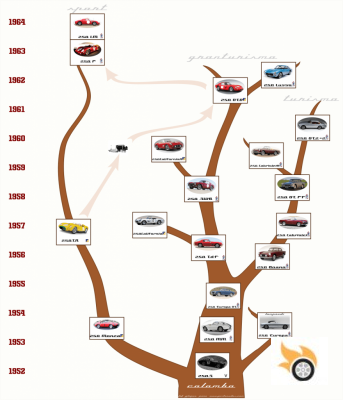In the range there were two categories: racing cars and street cars, although being the constructor Ferrari, the street models were not far from the tracks. In addition, there were models that belonged to both categories at the same time. The chassis of this series were built by oval tubes and panels forming the bodywork. The competition chassis were usually made of aluminium and the road chassis were made of steel. All models, except one, had the same 3 litre engine which was improved version after version. The first models were produced in tens and the last ones in hundreds.
The beginnings
Enzo Ferrari, the founder of this company, was neither an engineer, mechanic nor designer, although he was able to surround himself with the best professionals of the time. He didn't get along with all of them all the time, but he did know how to get the best out of each one of them. In fact, the work often lasted longer than the person. Our story begins with the first model of the brand, the so-called 125S. It was a small barchetta with a 1.5 engine and 12 cylinders designed by Gioacchino Colombo to compete in the races of the time. For Enzo, the future belonged to twelve-cylinder engines, hence the unusual configuration of this engine.
Ferrari has been an anachronistic brand from the beginning, applying solutions out of time, both by excess and by default. Colombo's talent was not only to design an engine and a chassis for it, but also to foresee evolutions of that engine. Thus, although its cubic capacity was reduced, the size of the engine block was big enough to grow by simply increasing the diameter of the cylinders. In this way we can use the same block, the same connecting rods and crankshaft, version after version. What needs to be changed is the machining of the block, pistons and cylinder head, so the engine can evolve little by little.
The reason for the sale of passenger cars by Ferrari was the need for cash to finance their careers, thus, began to sell what he did best, sports cars. In this way, and simplifying a lot, we go from 125 to 159, 195, 212 and 225. As you can guess, the vehicle code is the unit displacement of a cylinder, to know the total of the engine, just multiply by 12 that number.
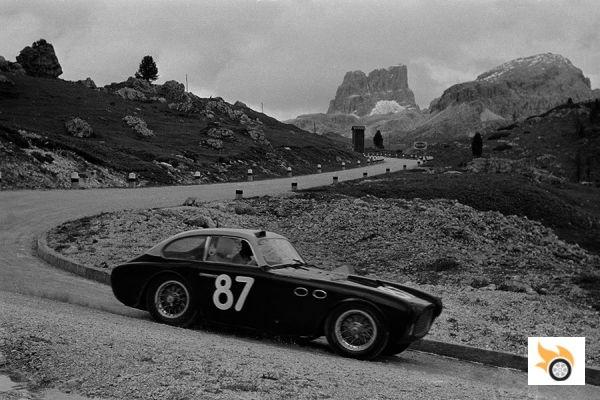
Ferrari 250 S (1952)
In 1952, a 225S chassis was fitted with a new version of the engine designed by Colombo, although he was no longer working for Enzo. The engine's cylinder bore was enlarged from 70 to 73 mm while maintaining the 58.8 mm stroke to bring it to 3 litres of displacement. The cylinder heads of this engine were modified from the previous model, with the design based on another engine, the Lampredi.
The 250S was a small and powerful car - the wheelbase was 2.25m and the engine output 227 bhp - which was very successful in racing. The bodywork was by Vignale. Its best title was first place in the Mille Miglia, ahead of the Mercedes 300SL, and it also achieved the fastest lap at Le Mans in the hands of Ascari, although he was unable to finish the race. It was a racing car, not a touring car. It is curious that in these years the cars already had dry sump, but they were satisfied with drum brakes, rigid rear axle and lever dampers, not telescopic.
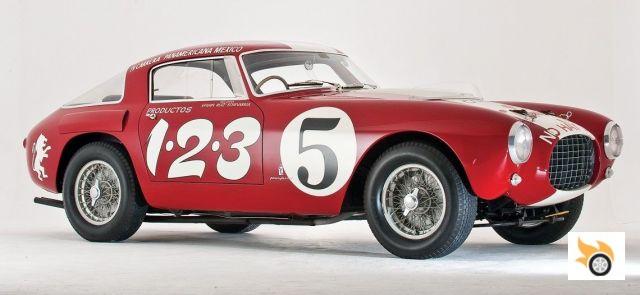
Ferrari 250 MM (1953)
This model is an upgraded chassis version of the 250S, named after the race won by the previous model. The design of the closed version was by Pininfarina, it was their first collaboration. Both Battista "Pinin" Farina and Enzo had spent years admiring each other's work, but their egos forbade each to visit the other's home. It was Sergio, Battista's son, who had the idea of bringing them together in a small town halfway between Modena and Turin. The result of this meeting was a relationship that lasted more than sixty years.
This model, curiously, could not finish the Mille Miglia race that year, but it was successful as in the GT championships. The wheelbase grew from 2.25 to 2.4 meters. The suspension was very similar to the predecessor model, the front suspension was independent double wishbone and the rear suspension was rigid with leaf springs, with lever dampers on both axles. The engine was simplified by giving it a wet sump and four synchronized gears instead of five without synchromesh, in addition to increasing the power to 237 hp. These changes made it more comfortable than the 250S, which was uncompromisingly sporty.
It was the first attempt to build a homogeneous GT series, as previous Ferraris were built entirely to the owner's design. In terms of design, the wrap-around, sloping rear window, the vertically positioned radiator grille, together with the low, elongated bonnet form the typical Ferrari stamp of those years. Although it did not have the sporting success of the previous model, it behaved very well in GT races. Of this model, 26 Pininfarina berlinetta-type units and ten Vignale barquetas were produced, a record for Ferrari production during those years.
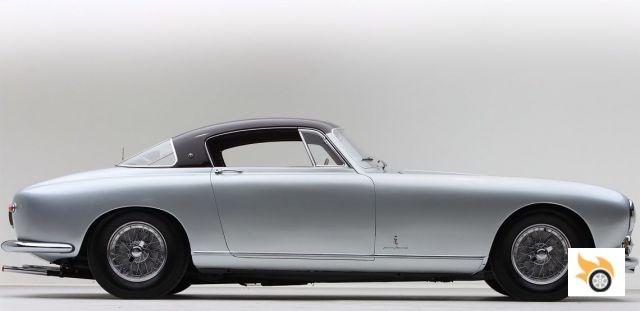
Ferrari 250 Europa (1953)
This model is the road version of that year, with the Lampredi engine, the only non-Colombo and Pininfarina design. Going back to the beginning, the first Colombo 1.5 engine was built with supercharging in mind, but it didn't work as well as the naturally aspirated one. As an alternative to this engine, Enzo hired Aurelio Lampredi, who designed alternative naturally aspirated engines. In addition to the racing engines, he designed a larger displacement 4.5 naturally aspirated V12, however, this engine never reached the level of the Colombo.
The 250 Europa is actually a 375 America - a coupe with the 4.5 Lampredi engine for the American market - but with the engine downsized to a 3-litre for the European market. The chassis had a wheelbase of 2.75 metres, making it Ferrari's largest car at the time. Although beautiful, the engine was not on par with the bodywork, this block was less powerful, bigger and heavier than the Colombo. This version was not as successful as expected and was replaced the following year. The Lampredi engine was never used again in the 250 series. A total of 22 units were sold, 17 built by Pinin Farina and 5 by Vignale, less than the MM, the sports equivalent.
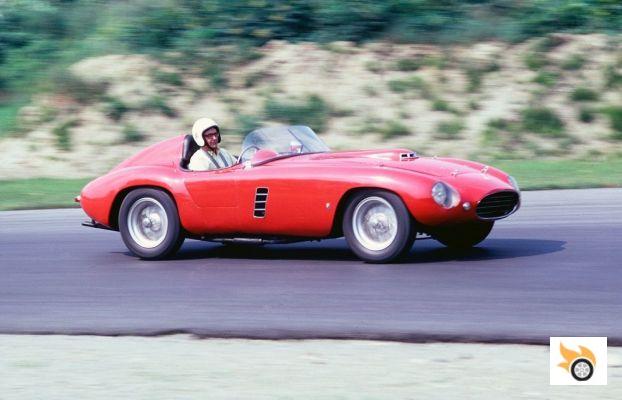
Ferrari 250 Monza (1954)
This year four barquetas were built with the 250MM engine. The chassis used was that of a 750 Monza. The gearbox was located on the rear axle. The engine was of light cast iron and the weight very contained, it was 850 kg.
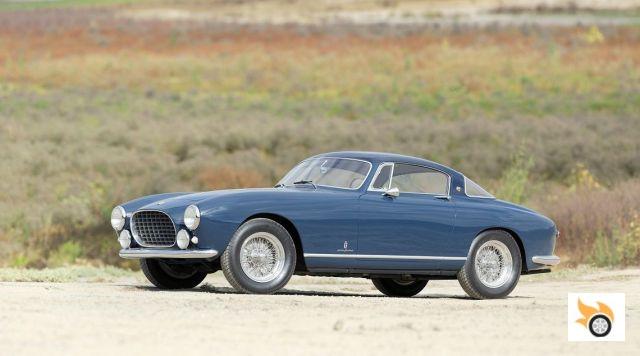
Ferrari 250 Europa GT (1954)
A new model appeared, in appearance equal to the previous Europa, but with two very important changes. It returned to the 250MM Colombo engine with somewhat softer settings. In addition, being a shorter block, it was possible to shorten the wheelbase to 2.55 meters. With this reduction, the engine and the car were much more balanced. The front suspension changed from leaf springs to coil springs. Soon the model became known simply as the 250GT, a name that would represent Ferrari's best work for ten years. From this model onwards, all Ferrari road cars would bear the Pininfarina stamp, right up to practically the present day.
The only exception in years gone by was the Dino 308 GT4 by Bertone; in recent years Ferrari has created its own styling centre called Ferrari's Styling Centre which started with the LaFerrari. The combination of the Colombo engine and Pininfarina design formed the ingredients for the construction of the GTs of this series and the next 275, 330, 365 and 412 in the mid-eighties. Of this series 36 units were built, one by Vignale and the rest by Pininfarina; it turned out to be the longest and most uniform series to date.
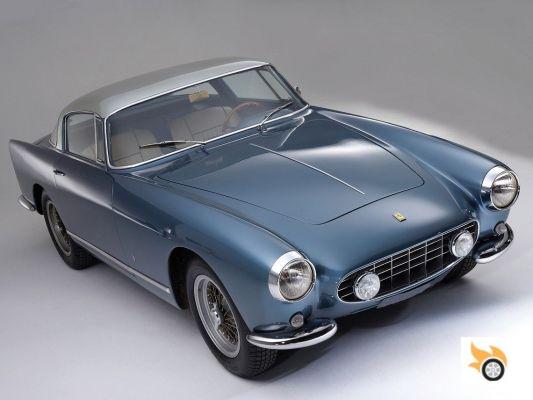
Ferrari 250 GT Boano/Ellena (1956)
In 1956, Pininfarina designed a new model with more robust lines continuing the styling of the Europa GT. He added slight tails and reduced the glazed area. As Pininfarina was expanding its factory, it was unable to take over production, so it contracted the coachbuilder Boano to take over. This, in turn, went to work for FIAT and left the workshop in charge of his son-in-law Ellena, who slightly changed the design again, mainly giving it a little more height inside.
That's why this series is known as Boano/Ellena or low roof/high roof respectively. These models were always based on the Colombo engine with the most comfortable configuration. 88 units were built, finally more passenger cars than sports cars were sold, Ferrari enters the market. A Ferrari 250 GT Speziale Italia model from the same year is on display at the Malaga Motor Show, a real collector's item with an enormous price tag.
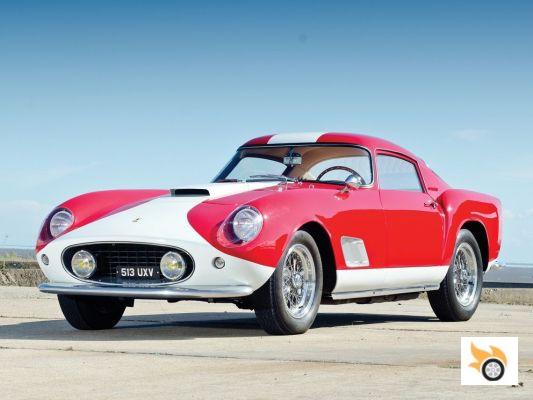
Ferrari 250 GT Berlinetta TdF (1956)
In 1955 there was the Le Mans Disaster, an accident with four vehicles involved in a pit entry resulted in the death of the driver, 83 spectators and more than 120 injured. Because of this, measures were taken on the tracks and cars, even Mercedes left the competition until the eighties. This accident showed that no safety measures had been taken with the cars: they used to be tiny, convertibles and without a real windscreen, remember the 250 Monza. One of the measures taken was to use homologated cars, real GT cars that we could race on Sunday and take to work on Monday.
With the last series of the previous 250 Europa GT, 9 units were built as prototypes for GT competition. The chassis was lightened and the weight was reduced to a minimum, only the windshield was made of glass, the rest of the windows were plastic; aluminum panels were also used. This model inaugurates the Berlinetta series, they were added a third volume and a hint of tails, remember that the fifties are the years of the tails in the U.S..
It won the hard race of Tour de France from 1956 to 1959, with this name is better known this model, because only if you win this race is allowed to use these acronyms, reused in a current model. It was a Pinifarina design that Scaglietti built in his workshops, the usual is that the competition series was built by the latter. There were five series, as they changed, the number of air outlets in the C-pillar sheet metal was reduced, the power increased from 240 to 280 hp. 77 were built in all series.
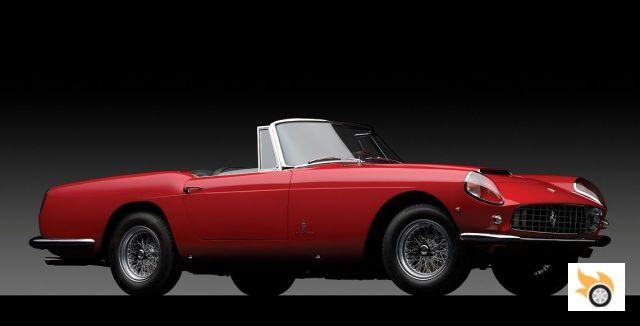
Ferrari 250 GT Cabriolet (1957)
The 250 series had been on the market for four years and had not yet been presented any series of convertible passenger cars, only a few models. At the end of the Boano series was built a convertible on which Pininfarina was based to make his cabriolet. It used straighter lines than the closed models on which it was based. The shape was more stylized, predominantly more lines than curves, the typical round grille is now fully elongated. The headlights generate a volume that runs cleanly across the top of the car down to the end of the doors to go back up just behind.
The straight windshield and the folding window behind it are characteristic of this model. It was a very luxurious, with the best materials of the time, and in which everything could be configured. It was built as a model in which you could drive fast, but, above all, very comfortable and very elegantly. It was priced at $14,950, even more expensive than the sporty versions of the time, it was not only the most expensive in the Ferrari catalogue, it was one of the most expensive cars of the time. 36 units were built.
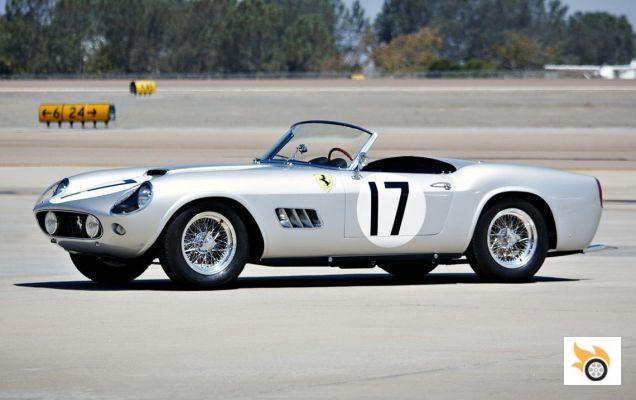
Ferrari 250 GT California (1957)
Luigi Chinetti, formerly a racing driver and at the time a Ferrari distributor for the United States, said that the Cabriolet was fine for cruising, but his customers wanted an open Ferrari for racing. So Scaglietti was commissioned to make the TdF version convertible. The California has the same chassis and 275 bhp engine. It could be ordered with the same sporty options as the 250 TdF. It also uses aluminum hood and door panels.
Again we have the two versions, this time of convertibles: the Cabriolet for road and the California for racing. One of them fast and the other very fast, one more luxurious than the other. The line of this model is more rounded, we emphasize that the windshield is more inclined and has only the bow, lacking glass behind it. Also typical is the air outlet behind the front wheel and the fog lights in the grille. To us, this convertible looks like a passenger car, but it was actually a racing car and one of them finished fifth overall in the 1959 24 Hours of Le Mans.
Of the 250 convertibles, this is the most sought after model, a model that belonged to the actor Alain Delon; it was considered missing for a long time, finally it was almost rusted in a castle in France along with other classics, it was sold for about 16 million euros. This model is the one that gives its name to the California of our days, whose first version inherits the intake on the bonnet and the air outlet behind the front wheels. Of this series 55 units were built.
Ferrari 250 TR (1957)
Ferrari prepared this 900 kg barqueta with transaxle gearbox and, finally, disc brakes and telescopic shock absorbers for the new 1958 homologation. The reliable three-litre Colombo engine was taken to the max, fitting six carburettors and revising the mechanics to increase power to 300 bhp, an output of 100 bhp/litre for a 60-year-old naturally aspirated car. It was one of Ferrari's most successful cars, winning 5 of the 4 World Championship races in 1958. The first versions with the hood separated from the fenders, are the most recognizable of the series and even of the sports cars of the time.
Behind the front wheels they have a gap that we call them fanguera, they are to prevent the mud from obstructing the passage of the wheel, the speed races of before were also run on land. The origin of its name Testa Rossa, is due to the fact that the cylinder head covers were painted red throughout the TR series as there were several models with different engines. The model of the eighties took its name, although it was written all together, and also had the cylinder head covers decorated in red. It was built 20 units being the designer and builder Sergio Scaglietti.
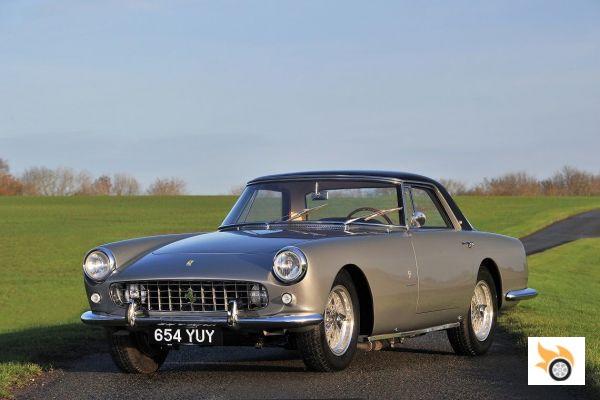
Ferrari 250 GT PF (1958)
The production of the coupé of that year was entrusted to Pininfarina, as the new factory was already operational. The intention was to make a more spacious and comfortable vehicle, in which the sportiness was a little aside. To do this, Pininfarina was based on its cabriolet, which simplified the lines making them purer, also expanded the passenger compartment and trunk. As expected, the engine and suspensions were the softest version, it could also be configured to measure.
Of this model 335 units were manufactured, now yes, almost all the same; finally the models are made in series and the number of prototypes is much lower than the production. An illustrious owner of this model was Ferruccio Lamborghini, a successful young businessman who made his living manufacturing tractors. He was very fond of sports cars and had Alfa Romeo, Mercedes 300SL, Lancia, Maserati and Jaguar in his garage, but when a Ferrari entered his garage, he never drove any other cars.
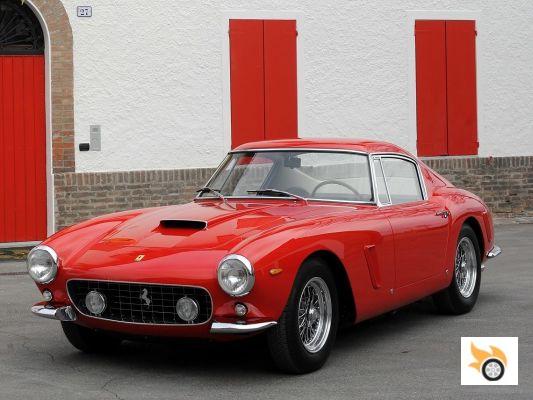
Ferrari 250 GT SWB (1959)
Ferrari continued to update the 250 TdF and, at the end of its series, produced 9 units that were to be the prototypes of this series, they were known as Interim. They started from the same base and engine of the TdF which they wanted to renew with three premises in mind: improve aerodynamics, provide comfort and adequate space for luggage and, finally, be as compact as possible. The chassis was updated, at last a standard Ferrari had disc brakes; the other important difference is that the wheelbase went from 2.6 to 2.4 meters. Because of this shortening the model is known as SWB (short wheel base in English or passo corto in Italian), this nomenclature made the previous models be called long wheel base or passo lungo.
Pininfarina's design was very successful, with sober and elegant lines that shouted from all sides that the car is a sports car. It is very identifiable by the lack of windows behind the side doors and by the smooth drop of the roof. It was the first Ferrari model in which aerodynamics were taken into account in its design. The combination of engine power, handling and performance made it the best Ferrari to date, an opinion also shared by Ferruccio Lamborghini.
This car was produced in street version, known as Lusso, and in sports version, with a lightened chassis, even with all aluminum bodywork and a boosted engine. However, lightweight versions were also produced for Lusso and sports cars with steel chassis, the race/road separation in Ferrari is never clear. It was another successful model in competition: Tour de France 60, 61 and 62; Tourist Trophy in 60 and 62; 24 hours of Le Mans in GT, 1000 km Nürburgring 61 and 62. Of all the Ferrari GTs, this was the one that achieved the best balance between road and track. As we said before, GT racing cars had to be homologated for road, 165 were manufactured in all series and versions, more than enough for that.
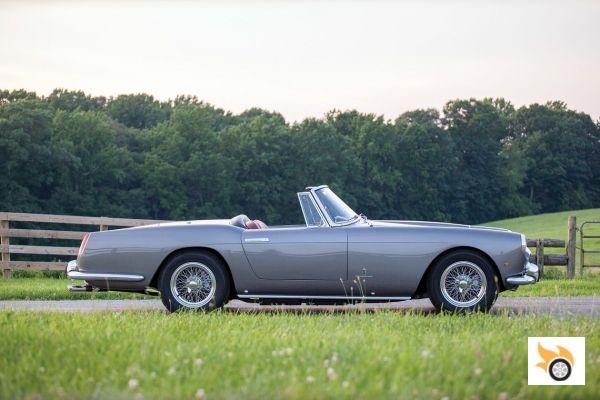
Ferrari 250 GT Cabriolet PF II (1959)
It was time to renew the Pininfarina convertible version. This series was based on the coupe of the moment, instead of being based on the previous convertible. Thus it used the updated version of the chassis and, as always, the 240 hp engine and all the luxury available at the time. The lines are purer than in previous models. The interior and trunk were more spacious. Of this series 204 units were built, more than the rest of the 250 convertibles of all the series.
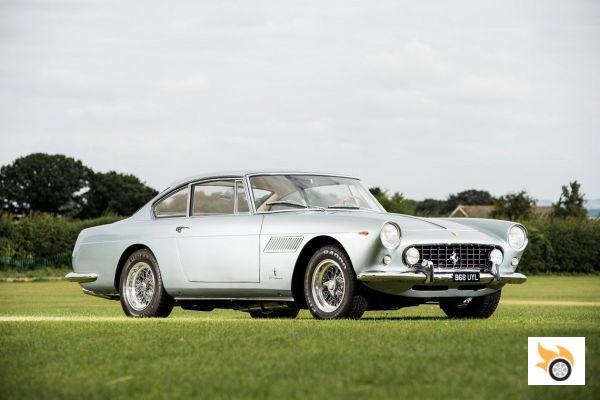
Ferrari 250 GT 2+2 (1960)
Ferrari had finally become a mass-producer. However, until then they had only produced two-seaters, they only made four units previously as 2+2, but by order. At this point they realised that they were losing part of the pie, as there was a real demand for a more versatile model with four seats and a larger boot and the costs of racing were increasing. According to Farina, they set out to build the first Ferrari 2+2 in series production.
The premises for this model were: four seats, bigger boot and, very importantly, it had to be a Ferrari. For this, the long wheelbase chassis version with disc brakes and telescopic shock absorbers was used with the 240 hp engine. As more space was needed for the occupants, the engine position was moved forward by 20 cm, it lost some balance, but this model had a more family-oriented approach. Some growth at the front for the relocation of the engine, but the part that grew the most was the rear. The line was inspired by Pininfarina's coupé versions with a very soft roof drop.
Very characteristic of this series, in addition to the second row of seats, are the engine ventilation slots above the front wheels. Despite being larger than the Boano, it seemed much lighter than the Boano. This model was a great success for the factory, 955 units were sold in three series. One of the lucky owners of this model was again Ferruccio. According to him, he loved it, but it suffered from the same problem as the rest of Ferrari: in normal driving it was perfect, but in aggressive driving the clutch slipped and he had to change it very often.
Fed up with this problem he went to Maranello to explain his opinion in person to Enzo Ferrari, with the intention of contributing his experience as a tractor manufacturer. He was kept waiting too long and when he explained the problem to Enzo it wasn't in the best way, he simply told him that his Ferraris were rubbish. Enzo's angry response was something like "Lamborghini, you may be a good tractor driver, but you'll never be able to drive a Ferrari properly". The rest of the story is already known, Ferrari lost a customer and gained a competitor, Ferruccio founded a sports car company that brought him the greatest joys and sorrows and we gain from the competition between them, because thanks to it both are forced to produce better cars every time.
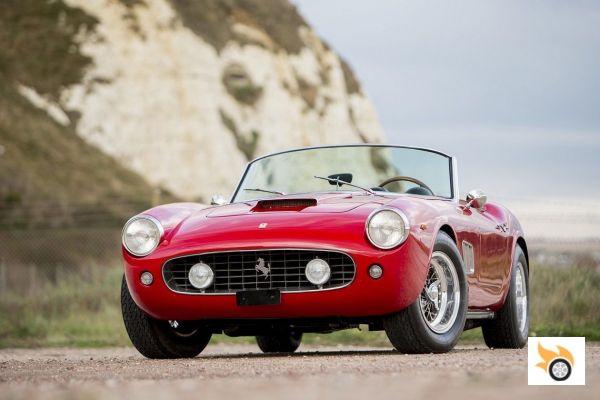
Ferrari 250 GT California SWB (1960)
This model, also designed and built by Scaglietti, has the look of the previous California, although shorter and somewhat wider, however it is a roofless version of the GT SWB, with the 280 hp engine and short wheelbase. It was much more focused on competition than the previous version. Of this series 56 units were manufactured. As in the previous series, there were steel versions with aluminum panels, others all aluminum. At the beginning the headlights were fairing, years later changed the rules and were without fairing at the end of its production. The latter show more similarity with the SWB giving it a sportier look.
Ferrari 250 GTO (1962)
In 1962, the FIA World Championship was to be for the GT, remember that they had to be production cars with at least 100 units built. In that year the rival to beat was the recent Jaguar Type E, according to Enzo the most beautiful car in the world. In 1961 the project was entrusted to the same team that led the development of the SWB: Giotto Bizzarrini, Carlo Chiti, and Mauro Forghieri. The project manager was Bizzarrini and the designer and builder Sergio Scaglietti and the basis was the 250 GT SWB. In these years mid-engined cars, more balanced in curves, began to compete. On the other hand, it was seen that although the SWB's line was aerodynamic, the nose tended to lift at high speed, it needed more lift.
The SWB chassis was modified by lightening and strengthening the chassis, the engine was moved as far back and as low as possible, to centre it and allow the nose to be very low. Bizzarrini studied the bodywork in the wind tunnel to correct the lift effect at high speed. For this reason the nose was very low and elongated. The radiator inlet was reduced and had three D-shaped openings that could be covered or uncovered according to the needs of the race. The line continues smoothly to the rear which had a small spoiler and ended abruptly following the Kamm tail scheme.
According to the theory proposed by this engineer, it is useless to continue the tapering line of the rear, this means that the rear of the Type E, for example, although beautiful does not improve aerodynamics, hence the vertical cut. It was fitted with the most powerful engine of the 250 series, that of the TR, we remember with dry clutch, six carburettors, 300 hp and its five-speed gearbox. The prototype was called il monstro because of the long and low nose and the three auxiliary entrances, however, painted and in the race the thing changed. Before the development of the car was finished, the Palace Revolution arrived. Both the commercial and engineering departments did not agree with the decisions taken by the management.
An ultimatum arrived: either Laura, Enzo's wife, would continue or they would leave. Almost the entire management left Ferrari, leaving Forghieri as head of engineering and Scaglietti as head of design and construction. It looked like Ferrari was going to disappear, however from 1960 to 1965 it won every race at the 24 Hours of Le Mans and sales increased. The testing continued and finally the development of this new GT was finished. There was only one thing left to do, to homologate it. We remember that for this, at least one hundred units had to be built to be registered.
Enzo was not willing to do that, so he convinced the FIA that the car he was going to race was only a slight modification of the SWB, which was already homologated. When it got homologation a telegram was received at Maranello that said something like "250 GT O" for omologato, we already have one of the most famous names in Ferrari and motor racing in general. It was a very successful car in racing, winning the World Touring Car Championship three years in a row. Let's not forget that this car was also a road car. However it had just enough to go for it, inside there was no luxury, it had no speedometer and the windows were plastic.
It didn't have any lining inside the cabin either, the seats were spartan, it even lacked a bellows on the gear lever leaving its grille in sight. Yes, this is the origin of the typical Ferrari gearshift grille, to make a car as light as possible. As for its design, it has been a constant inspiration for all Ferrari GTs up to the present day, especially the front-engined ones. 33 units were produced in the first series and 3 in the second, retouched by Pininfarina. It is surely the most desired car for collectors, one of them was sold for 38 million dollars, breaking previous records.
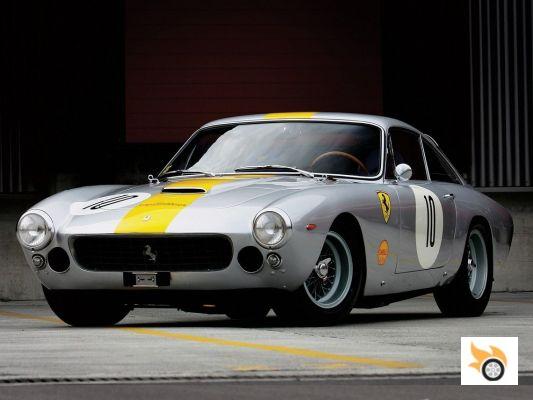
Ferrari 250 GT Lusso (1962)
This was the last GT of the 250 series. Pininfarina was commissioned to design it and built another marvel on wheels. It was an aerodynamic coupe with two very spacious seats. The space behind the seats was reserved for luggage, you could order matching suitcases, that option cost today the same as a compact. It had very smooth, sinuous and balanced lines, making it look small. The characteristic air intake on the bonnet now had a grille. The radiator grille was very elongated, leaving the headlights exposed at the ends.
These generate a volume, but more subtle than in previous models, which ends up melting in the middle of the door and do not go beyond there. The rear forms a volume that decreases until the end. The final part ends in a small spoiler, Kamm tail and tail lights are twins, large and round. This rear end is a constant inspiration for Ferrari, even today. The interior breathes luxury, which is what Lusso means, in terms of materials and space. Its interior is the most recognisable Ferrari interior, the speedometer and rev counter are in the centre of the dashboard, not behind the steering wheel.
As for the engine, it was the 240 hp engine, slightly advanced to give more space and with a five-speed gearbox. The chassis was based on that of the GTO, with a smaller section in the tubes, the hood and doors were made of aluminum, the rest in steel. This car was designed as a quiet GT, with which you can go comfortable, fast and very elegant, but a Ferrari is a Ferrari and some of them ended up in the races. If the car is beautiful on the street, with racing livery it's even better. It is strange that in the 60's exterior mirrors were no longer mandatory and the shape of the bumpers was decided by aesthetics, not safety. However, the American regulation was still in force that the headlights had to be round, twin and seven inches, which made the cars of those years perfectly identifiable. Of this model 350 units were manufactured.
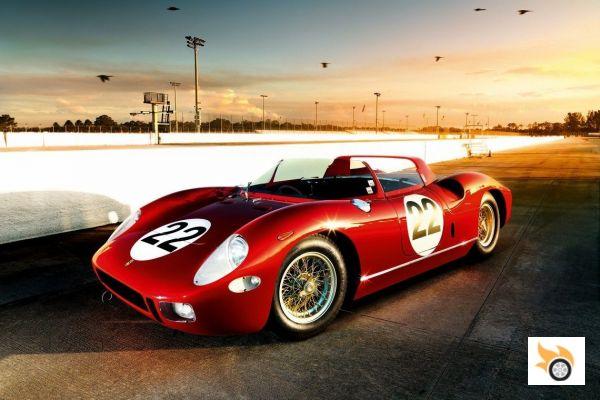
Ferrari 250 P (1963)
Enzo finally surrendered to the evidence that mid-engined cars were more suitable for racing. A new chassis was created with a construction similar to all Ferraris, tubular structure with oval profile tubes, but completely updated. The configuration is rear mid-engine and independent suspension on both drive trains with telescopic shock absorbers and disc brakes. This chassis was premiered in 1961 in the 246SP model and was used again with the 250TR and GTO engine revised and boosted to 310 hp for this model. It was a barquette to which a roll bar was added. The design was very refined and was by Pininfarina. It won the Sebring, Le Mans and Nürburgring races. Four units were built.
Ferrari 250 LM (1963)
This version was the road model of the 250 P. Enzo tried again to convince the FIA to homologate it because, according to him, it was another slight modification of the SWB, but this time he didn't succeed. This model was left in no man's land, it could not compete with other GTs and was not powerful enough to compete in the prototype category. This design was also by Pininfarina making a very pure design with a small roof and the rear window hidden in it or with a plexiglass cover.
It was the last Ferrari to win at the 24 Hours of Le Mans, this time in the private team NART. Although 32 units of this model appeared with this name, only the first one had the 3 liter engine, the rest had the 3.3 that later would mount the 275 model, so it would be more correct to call them 275LM. It is not well known to the general public, but one of them was sold at auction for 14 million dollars. Two of them were adapted to drive as touring cars.
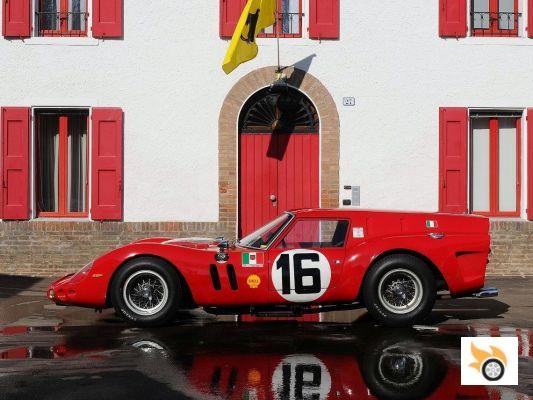
Ferrari 250 Drogo (1962)
In 1962 the owner of Scuderia Serenissima, Giovani Volpi, wanted to buy a 250 GTO to race it, but since he hired engineers fired by Ferrari in 1961, Enzo refused. When he couldn't get one of them, he hired the father of the creature, Giotto Bizzarrini and Piero Drogo, an experienced coachbuilder but outside the direct scope of Ferrari. They went back to the same steps, they started from a 250SWB and placed the engine as far back and as low as possible. They reworked that engine by boosting it with six carburetors and adding a dry sump to go very low, as it wasn't the TR's engine.
It stayed with the four speed gearbox. It was lighter than the GTO, 935 kg compared to 1,000 kg. The exterior line was more radical, it was lower than the GTO and also the Kamm tail finish was more pronounced. It was so shocking that the French press called it La camionnette, and today it is known as the Breadvan, the bread van. It is said that the change was made in fourteen days. It was a car that Ferrari at first rejected as theirs, today it is accepted as a 100% original Ferrari.
This is, very briefly, the story of Ferrari's most relevant series. The series starts with a small car that was gradually increased in power. As it grew, the chassis was perfected and lighter materials were introduced, we arrived at the TdF. It continued to be perfected by adding disc brakes, springs and telescopic shock absorbers, we are talking about the SWB.
Finally, aerodynamics entered into the concept of a sports car, it was made lighter and a more powerful engine was placed as low and centered as possible, we arrived at the GTO. The final step is to place the engine in its center and independent suspension in both trains, the 250LM. As for the street versions, we went from being a short series based on the sports model to make the versions more and more luxurious and sportier. Similarly you can also see how the history of a 3-liter V12 engine that was improving and going from vehicle to vehicle more and more perfect.
